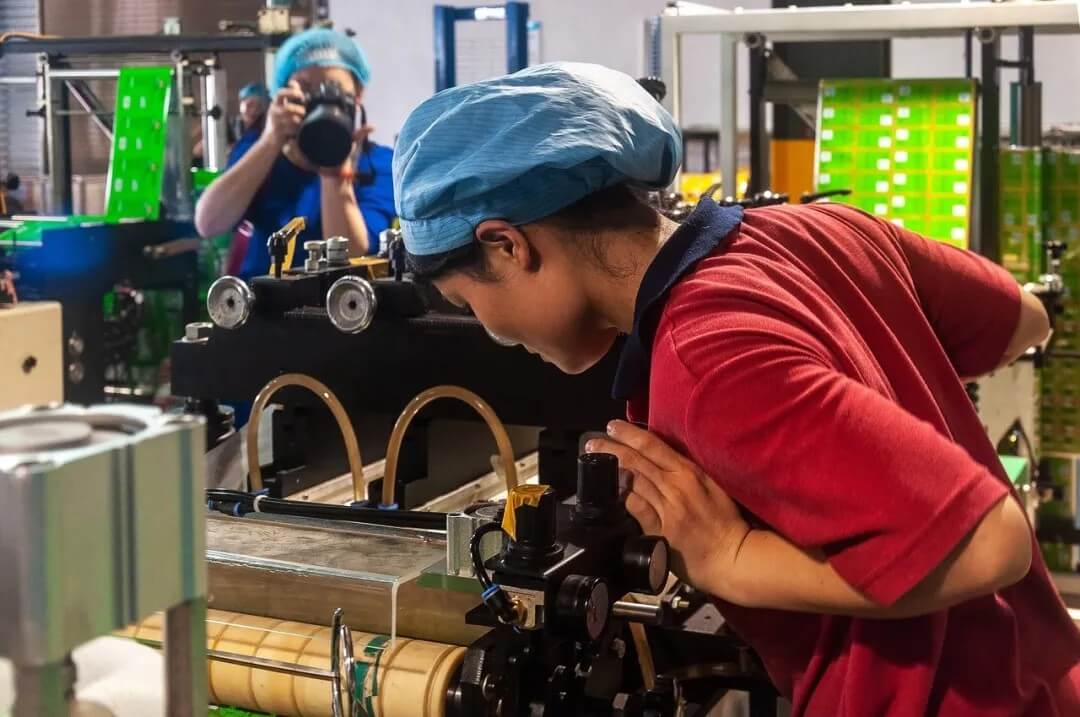Innovation is Always the Core Competitive Advantage of Enterprises. Southeast Asia has become the most important destination for Chinese manufacturing companies to relocate abroad.
From 2021 to 2023, China's cumulative investment in Southeast Asia’s manufacturing sector exceeded $40 billion, far surpassing regions like Europe and Latin America. Countries like Indonesia, Malaysia, Vietnam, and Cambodia have attracted large amounts of investment from China. These businesses are mostly in labor-intensive industries such as apparel and textiles, electronics manufacturing, and machinery production, including top companies like Luxshare Precision and BYD.
The reason why Chinese manufacturers are eyeing Southeast Asia is due to its proximity to China, abundant low-cost labor resources, as well as Southeast Asia's trade advantages and consumer markets.
However, an unnoticed change is gradually casting a shadow over Southeast Asia's manufacturing enterprises.
With the rise of Southeast Asia's digital economy, freelancing jobs such as food delivery and livestreaming are becoming new career choices for young people. What happened in China eight years ago is now unfolding in Southeast Asia—young and strong workers are starting to leave factories and join emerging industries like food delivery and livestreaming.
"As of now, young people would rather work as delivery drivers or couriers than go to factories," said Cao Dewang, founder of Fuyao Glass, highlighting the same phenomenon now occurring in Southeast Asia's emerging manufacturing bases.
Southeast Asian Factories Struggling to Find Workers
In 2024, one of Vietnam's most widely read news outlets, VnExpress, reported a severe labor shortage at Samho Shoe Factory, located in Cu Chi District, Ho Chi Minh City.
As a key supplier for Nike in Vietnam, Samho Shoe Factory once employed over 10,000 workers at its peak. Due to difficulties caused by the pandemic in recent years, the factory was forced to cut its workforce to around 6,000.
Layoffs were easy, but hiring has become a challenge. As the factory's order volume returns to normal, they are finding it difficult to recruit new workers.
After the 2024 Lunar New Year, Samho Shoe Factory found itself with 1,500 vacancies. To quickly ramp up production, the company offered monthly salaries ranging from 7 to 8 million VND ($275 to $314) and provided travel reimbursements for applicants. Yet, the results were underwhelming.
In response, Samho's management implemented a series of measures: encouraging previously laid-off workers to return with their previous salaries and benefits; offering a 600,000 VND bonus for new workers who stay for two months, with additional bonuses of 400,000 VND for each extra month worked, up to 48 months; providing a 500,000 VND housing allowance for workers from outside the area; offering full attendance bonuses, travel allowances, and other benefits; and paying additional childcare allowances for workers with children under six months old.
Despite these efforts, two months later, Samho Shoe Factory had managed to hire only around 300 people.

Image: Workers in a Southeast Asian factory.
The difficulties faced by Samho Shoe Factory are not an isolated case.
In the new Bình Dương Industrial Zone in Ho Chi Minh City, a textile factory called Qingkang is in urgent need of over 1,000 workers, but few young people have shown interest in applying.
The head of the human resources department, Mr. Tan, explained: "Textile industry jobs have little appeal to young people in Vietnam. Due to the lack of workers, even though we have received many orders, we are unable to meet our production targets."
Even more troubling, a newly opened shoe factory needed to hire 9,000 workers, but despite all efforts, they could only recruit about 5,000, and several hundred employees were quitting every month. The manager sadly acknowledged that the recruitment target was impossible to achieve.
The situation is no better in Malaysia.
As one of the world’s largest producers of natural rubber, Malaysia's rubber industry has long been a pillar of its economy. However, in recent years, the older generation of rubber tappers has gradually dwindled, and young people are increasingly unwilling to take up this job. Over the past decade, labor shortages and high production costs have led to a decline in Malaysia's rubber output.
On January 4, 2024, Malaysia's Minister of Plantation and Commodities, Zohari, held a press conference admitting that Malaysia has about 420,000 hectares of rubber plantations, but due to a labor shortage, they are unable to harvest the crops. The estimated loss could reach 2.3 billion Malaysian Ringgit (approximately 3.5 billion RMB). Based on the requirement of one worker per hectare, Malaysia needs at least 70,000 workers to resolve the issue.
"If the government does not take action, this will impact the country's economic growth," Zohari warned.
As a result, just after the press conference, the Malaysian government announced a relaxation of employment policies for foreign workers in key industries such as manufacturing, construction, and plantation sectors, allowing employers to hire foreign workers from 15 countries without meeting some of the previous conditions.
However, some people have pointed out that foreign workers often have mismatched skills or lack expertise, so the feasibility of this plan remains uncertain.
The Impact of the Digital Economy on Factories
The labor shortage in Southeast Asia is largely driven by the transformation brought about by the digital economy.
Thanks to its advantageous geographical location, large and youthful population, open and inclusive systems, and deep regional integration, Southeast Asia has witnessed a wave of digital economic growth in recent years.
According to the Southeast Asia Internet Economy Report, the digital economy in Southeast Asia reached $218 billion in 2023, growing 11% year-on-year, well above the global average.
Compared to the tedious and labor-intensive work environments of traditional industries, the digital economy, with its networking and intelligence, has given rise to many flexible and independent job opportunities that are clearly more appealing to young people.
Tan, a 25-year-old from Vietnam, joined the Grab platform as a ride-hailing driver in early 2024. Before that, he worked in a car parts factory in Hanoi.
After graduating high school, Tan joined the factory and worked long hours to earn around 10 million VND per month (approximately 2,939 RMB).
According to data from Vietnam's General Statistics Office, the average income for urban workers in Vietnam in the first quarter of 2023 was 8.6 million VND (about 2,527 RMB), while rural workers earned around 6.1 million VND (about 1,793 RMB).
While Tan's income as a ride-hailing driver is not as high as his factory wages, he is satisfied: "At the factory, I was often scolded by my supervisor, which made me unhappy. Driving for Grab pays less, but it’s more flexible and not as tiring."
Susi, a 29-year-old woman from Indonesia, worked in both an electronics factory and a shoe factory. Unable to withstand the harsh working conditions, she quit her factory job and enrolled in a six-month Chinese language course locally.
Now, Susi works as a domestic helper in Taiwan, taking care of an elderly couple, earning three times her factory salary, and without the fatigue of factory work.
In 2021, as TikTok Shop expanded into Southeast Asia, live-streaming e-commerce quickly became a local trend. A Laotian university student, keenly aware of this new opportunity, seized it.

Image: Southeast Asian girl live-streaming.
This student, known on Facebook as "yenly phettavanh," started her entrepreneurial journey at 14 by selling clothes. She then switched to selling cosmetics at 15, and chemicals at 16, but earned little. At 17, she went into debt for 30 million Kip (Laos' currency, with 10,000 Kip = 3.3 RMB) when trying to run a clothing factory.
Over the next two years, she tried various jobs to repay the debt, but with little success. However, when live-streaming emerged, it turned her fortunes around. She began selling massage oils through live-streaming, earning 10 billion Kip in six months, clearing her 3 million Kip debt and making an additional 7 million Kip in profit.
Compared to the older generation, Southeast Asia’s younger generation is more open-minded. For them, life should be free and diverse, and they believe that young people should explore more opportunities instead of spending their youth within the walls of a factory.
Behind the Labor Shortage, the Weaknesses in Southeast Asia’s Labor Force
Profit-seeking is inherent to capital. One key reason why manufacturing industries are flocking to Southeast Asia is the enormous demographic dividend available in the region.
According to statistics from the General Statistics Office of Vietnam, by the end of 2023, the total population of Vietnam was approximately 103 million, ranking third in Southeast Asia, only behind Indonesia and the Philippines. It is the 15th country in the world with a population of over 100 million.
The data shows that the average age of the Vietnamese population is 32.5 years, with 70% of the population being of working age. Indonesia's population, which ranks fourth in the world, has 260 million people, and among them, more than 65 million people are aged between 20 and 35, accounting for 50% of the working-age population.

Image: Vietnamese workers after work.
However, the seemingly promising labor market in Southeast Asia has become a fatal weakness for its manufacturing industry.
First, Southeast Asia’s Workforce Quality Is Not High
Take Vietnam as an example. The labor force in Vietnam has a training rate of only 67%, and only 27% hold diplomas or certificates, which limits them to simple processing industries such as textiles and apparel, electronic component assembly, and wood processing – all labor-intensive sectors.
Even in Vietnam's higher education system, the configuration of disciplines is heavily skewed towards the humanities, while engineering and technical fields like mechanical, electrical, and automation engineering are relatively well-developed. Other fields such as optics, optoelectronics, and industrial engineering are extremely rare, or even nonexistent. According to data from the Ho Chi Minh City Hi-Tech Park Training Center, Vietnam has an annual shortage of at least 20% of its high-level talent, and it will be difficult to fill this gap in the short term.
Across Southeast Asia, literacy levels vary significantly from country to country. According to research by the United Nations, the average literacy rate in ASEAN countries is over 90%, but there are considerable differences between nations: Vietnam's adult literacy rate has reached 97%, Indonesia's is 69%, Cambodia’s is 74%, Myanmar’s is 76%, and Laos has a literacy rate as low as 58%.
What is even more concerning is that the lack of high-quality talent is hindering research and innovation in manufacturing. As a result, local factories can mostly only rely on low-end products to survive, and without exception, these industries face problems such as long hours, high intensity, and poor working conditions, making them unattractive to young people.
Thus, a vicious cycle is born.
Second, Southeast Asia's Labor Force Is Highly Vulnerable to External Factors
Although the overall economic size is not large, since the implementation of the Doi Moi (Renovation) policy in 1986, Vietnam's GDP has grown at an average annual rate of 6.5%. In recent years, driven by an export-oriented economic structure, the country’s economic index has soared. However, the housing market has also soared alongside this economic growth.
Data shows that over the past five years, Vietnam's real estate market has gone through several booms, with land prices increasing by more than 50%. The booming real estate sector has led more young people to leave factories and switch to careers as real estate agents.
A real estate agent interviewed by Vietnam Express revealed that by closing a property deal worth around 30 billion VND (approximately 900,000 RMB), an agent could earn nearly 10,000 RMB in commission—much more than working in a factory.
Influenced by Western culture, hedonism has become popular among Southeast Asian youth in recent years, which has somewhat reduced their enthusiasm for factory work.
Unlike the hardworking older generation, this generation of Southeast Asian youth values consumption and enjoyment. Even when they have to work to make a living, they often prefer environments like shopping malls and supermarkets.
In this regard, the head of the factory for American furniture manufacturer Lovesac in Vietnam agreed, stating: "Nowadays, young people in Southeast Asia all have smartphones, and are deeply integrated into global culture. They listen to the same music as young people in the United States, watch the same TV shows and reality shows, and they don’t want to endure factory work."
Industry Upgrading: A Challenge for Global Manufacturing
As young people flee the factories and manufacturing industries struggle, it’s not only the business owners but also government officials who are worried.
Just recently, the Vietnamese government issued a 2030 development strategy for the semiconductor industry, with a vision extending to 2050. Thailand's Board of Investment (BOI) also released measures to promote investment aimed at bringing the Thai industry to Industry 4.0. Indonesian President Joko Widodo recently announced the launch of the "2025–2045 National Long-Term Development Plan," with a major strategic focus on industrialization and innovation in response to the current global technology-driven trends.
But without a mature labor force, even the grandest plans will become illusions.
Therefore, Southeast Asian labor departments are continuously introducing new policies to help factories adjust their environments and benefits to meet the demands of young workers.
Some factories in Vietnam have started providing workers with coffee, milk tea, and other beverages, and offering free dance classes. Other factories have improved cafeteria standards and created daycare centers for employees' children. Luxshare, a company in Vietnam, has even built new dormitories, complete with entertainment functions like TVs.
In Malaysia, some factories no longer force employees to wear uniforms, creating a more harmonious and relaxed work environment. As Syed Hussain Syed Husman, the chairman of the local employers' association, stated: "We are trying to make the factories more attractive, with bigger spaces, better lighting, and beautiful music playing."
Some companies have relaxed skill requirements for workers, incorporating training as part of factory costs. Richard Jackson, the general manager of a recruitment company in Thailand, remarked: "Factories either need to spend more money on the skills they want, or compromise on the abilities they need."
However, these benefits come at a high cost, leading to a rise in manufacturing costs.
Since July 2022, Vietnam’s minimum wage has increased by 6%, and this increase has continued for more than a decade.
According to data from the International Labour Organization (ILO), factory wages in Vietnam have more than doubled since 2011. The average salary in factories now reaches around $320 per month (approximately 2,328 RMB), which is three times the wage increase rate in the U.S.
Some analysts believe that in the past three years, Vietnam's labor costs have increased by around 20%, and in the next three to five years, they may reach the level of China.
The continuous rise in labor costs has sparked concerns among more than 20% of foreign-invested manufacturing enterprises in Vietnam: "If we keep raising wages to retain workers, will the compensation match the actual capabilities?"
Some entrepreneurs also express that "raising wages to retain workers has extremely limited effects. Because when the minimum wage increases, it often drives up rents and prices. Instead of focusing on raising wages, the government should strengthen balanced industrial development. Only in this way can the labor shortage problem facing manufacturing industries improve."
Southeast Asia's Labor Shortage Also Serves as a Wake-Up Call for China’s Traditional Manufacturing Industry
In the long run, under the dual impacts of the digital economy and an aging population, traditional manufacturing industries that rely solely on low-cost labor are clearly unsustainable.
The key challenge now for every company deeply involved in manufacturing is how to leverage digital technologies to drive smart manufacturing, upgrade products, and increase product value.
Because innovation is always the core competitive advantage of enterprises.







